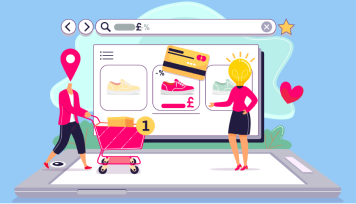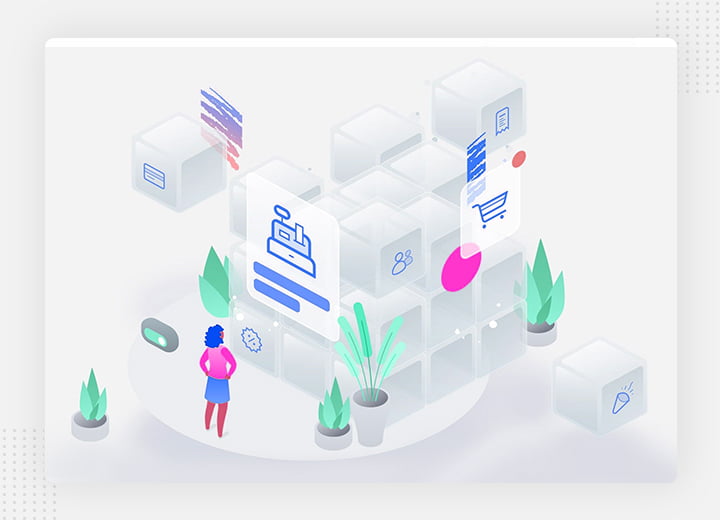A Complete Guide To Headless Commerce
What is headless commerce? How does it work? Should I invest in headless commerce solutions? Don’t worry, we have covered all of your doubts in this ultimate headless commerce guide. Tune in!
- October 18, 2022
- by Rajeev Nar


Headless commerce in eCommerce
Headless commerce is the new fancy term that is making a lot of noise in the UK ecommerce industry. Although headless commerce has been in practice for the past few years, many digital entrepreneurs are still strangers to this amazing concept. If you’re one of them, then we’ve got you covered. We have curated this ultimate headless commerce guide to help you understand what it is, how it works, how it can benefit your business and how you can get started. But that’s not all we have taken care of, to help you even more, we will also take you through some use cases of headless commerce solutions. So, what are we waiting for? Let’s dive in!
What is Headless Commerce?
Headless commerce, in the simplest words, is the separation of the back end and the front end of any eCommerce website or application. More specifically, the visible elements of the site that the users interact with (the front end) is separated from the back end(the codes and other technical parts). And here is the interesting thing, because the front-end is known as “head”, it is known as “headless commerce”.
This disassociation offers great flexibility to the business owners as they can easily make changes to the front-end to improve their customer experience without worrying about the technicalities. That simply means merchants can enjoy several options and functionalities that would otherwise be unavailable to them, including the following :
- Businesses are free to use any front end tool that suits them and their business, independent of the ecommerce platform they’re using.
- Merchants can add new technologies, new channels and offer new experiences to their customers, easily and quickly.
Amidst the cut-throat competition in the eCommerce industry, customer experience is the most important factor that allows businesses to stand out from millions of their kind. And this is exactly where headless commerce comes to the rescue. Using it, brands can make quick changes to their outlook and usability so they become accessible from all kinds of web devices, from laptops, smartphones to smartwatches. Here is the main deal, all these varied front end interfaces can be handled from a single back end — ‘headlessly’.
How Does Headless Commerce Work?
As discussed earlier, headless architecture de-couples the presentation layer — the front end of a website or mobile application— from the underlying ecommerce platform — the back end.
In this scenario, the underlying ecommerce platform still handles the back end tasks, for instance, inventory management, payments, checkout, security, etc.
However, rather than being fully integrated or intertwined like traditional commerce, the front end and back end communicate via API (Application Programming Interface) calls that send data between them while your customers are provided with a hassle-free commerce experience.
Headless Commerce Vs Traditional Commerce?
To help you understand the headless commerce approach even better, let’s compare it with traditional commerce.
The detailed comparison between the two commerce models highlights some of the key benefits of headless commerce. So, you’ll know what this hype is all about!

1. Traditional Commerce
The traditional e-commerce model is the one in which the front-end and the backend of a site is tightly coupled. Here, the backend contains the code and content for the plugins and layout used on the front end.
In short, everything is closely packed. This can have some great advantages like — a simple and clean solution can be great for SMEs planning to sell online quickly, especially when they are sure that their business will not grow complex over time.
However, some businesses grow more quickly than others and they realise the need for changing the front-end of their store or website in order to provide a better experience to their customers. But they are restricted by this coupled nature of the traditional commerce model. Even if they try to tweak the front end, they end up messing with the backend code, which results in serious consequences.
2. Headless Commerce
Headless commerce is all about flexibility. It offers great opportunities to the businesses to customise their website in the way their business demands and customers like.
In this model, the front-end is not dictated by the back end or any ecommerce platform. It’s totally up to you what front-end platform you want to use. You can either use an existing front-end design, a stylish template or a completely fresh design built from scratch!
Practically, this disassociation means that your development teams can create multiple brand experiences for different channels and tailor them to your customers needs. Here, APIs are used to deliver commerce and content to websites, applications, social platforms, smart devices, and so on.
The biggest advantage of this commerce model is, it allows you to offer a personalised customer experience across channels that brings greater good to your business.
10 ECommerce Growth Strategies- Guide

Why Should You Consider a Headless Ecommerce Model?
Let’s take an example, almost every ecommerce business is secretly wishing to overtake Amazon — the king of Ecommerce. But most of us know the fact that it is nearly impossible to beat Amazon for the choices and price range of products they offer their customers. Amazon’s biggest secret to success is the splendid customer experience they provide.
The good thing is, the headless approach can offer you the same advantage. With greater personalisation and customisation, you can tailor commerce and content according to the needs of your shoppers. It lays a ground for greater innovation and creativity, which is nearly impossible with the traditional ecommerce model. And not to forget, by proving your customer experience, you can automatically improve your conversion rates and profits.
Still not convinced? Here are some reasons why headless commerce has become the first choice of many eCommerce businesses.
1. Fast and Visionary Websites
First and foremost, headless commerce presents you with the opportunity to test new technologies and find the best one that blends in with your site.
With this commerce model, you’re free to use the best front end solutions offering advanced personalisation, lightning-fast loading speed, along with the “crème de la crème” back end infrastructure
2. Offers-Flexibility-and-Familiarity-To-Developers
Another great benefit of using headless commerce is that it allows the developers and merchants to select, mix and match different technologies and platforms to combine ecommerce as well as content. This helps in creating different shopping experiences rather than fitting in with the prebaked solutions.
For instance, you must already know that WordPress is one of the most popular content platforms. However, it doesn’t convert to eCommerce that easily. But with a headless model, it doesn’t matter as you can combine the CMS platform with any ecommerce platform you like.
In other words, you can use a CMS like WordPress in conjunction with a great ecommerce platform, say BigCommerce to enjoy the benefits of both worlds.
3. Offers Speed For Global & Omnichannel GTMs
The same principles, functionalities and strategies that allow you to create personalised experiences for your existing markets, will also allow you to expand your business in other markets and channels. Using headless commerce, you can fulfil your customer expectations regardless of the location they are sitting in.
4. Lowers Customer Acquisition Costs
Customer acquisition is one of the most important tasks for online businesses, but relying on paid channels can be an expensive affair.
Headless commerce allows you to reduce the customer acquisition cost in the following ways :
- By Creating Different User Experiences
Customers prefer shopping from sites that make them feel important. And this is where custom experiences kicks in. Your ability to create a unique shopping experience can drastically improve your conversion rates and help you make the most of your acquisition expenditure. Headless commerce allows you to develop excellent content and experience that drives high volumes of organic traffic to your site.
- By Providing Complete Ownership of the Site Structure
In a tightly coupled architecture, or the traditional ecommerce model, decisions regarding the site architecture mostly depend on the backend. For instance, you may want to implement new SEO features, but you can’t do so because they mess with the architecture of the backend. Good thing is, there are no such limitations with headless commerce. Your decisions regarding the front end will not be controlled by the backend.
So, these are a couple of reasons that show why you need to give headless commerce a thought. To clear your mind a little bit more, let’s look into some headless commerce use cases.
Top Headless Commerce Use Cases
There is only one thing you need to fit into your mind, headless commerce is an effective solution as it can be tailored to the specific requirements of your eCommerce business. It has a multitude of use cases to prove this fact!
1. Content Management System (CMS)
Having a CMS in combination with a headless setup opens doors for numerous options for content delivery as well as presentation.
For instance, you can use WordPress for top-quality content. Because it is the most liked CMS in the world, it will be much easier for you to find the WordPress expert content teams and developers that are familiar with the same.
What it means is that the content or marketing teams are not compelled to compromise on their CMS, which can be a huge problem with some ecommerce platforms. With a headless solution, the CMS of your choice can work hand-in-hand with any ecommerce platform you like.
Moreover, for content-focused businesses, headless commerce means that they can combine the best ecommerce platform with the best CMS.
2. Custom Solutions
The beauty of headless commerce is that it offers great flexibility in your technical stack. If your team is an expert in the features of a CMS you’ve been using for years, why let go of that useful knowledge simply to launch a new ecommerce store? What you can do instead is, add the ecommerce functionality you like, and headlessly deliver it to the systems your team understands and loves.
Also, you can utilise a single system on the front end, while using a whole range of systems at the backend — such as a custom interface in-store, a watch interface, a robust CMS like WordPress or even an off-shelf CMS in combination with custom React features.
Adding new elements to the technical stack can impose many problems in a coupled ecommerce architecture (traditional commerce platforms). A headless solution, on the other hand, lets you choose the front end systems you like, without disrupting the back end.
3. Progressive Web Apps (PWA)
Progressive Web Applications (PWA) bring intuitive web experiences to multiple devices, allowing your marketing and content teams to deliver commerce and content in an effective manner, regardless of the device or channel your customer uses.
With a great number of customers using smartphones for commerce, content and more — Progressive Web Apps allow brands to keep up with their customer requirements and personal preferences, and to maintain a topnotch user experience across different devices.
Using a headless solution, you can still use PWAs for the visible presentation layer and allow your teams to optimise the frontend user experience without tweaking the back end.
4. Digital Experience Platform (DXP)
Digital experience platforms or DXPs allow content and marketing teams to tailor and enhance the shopping experience for different customers. For instance, a great DXP will allow content to be optimised according to the preferences of different users, which in turn open doors for better merchandising across different devices and improve conversions.
Because headless is API driven, it can work well with the marketing teams using DXPs. In other words, you can combine your eCommerce platform with a DXP of your choice.
You’ve just learned about the headless commerce use cases. And if you’re wondering about the actual companies utilising this eCommerce model, then we’ve got you covered… again!
How Do Other Companies Use Headless Commerce?
You’ll be glad to know that two of your most favourite companies in the world are utilising headless commerce solutions. We are talking about Amazon and Netflix.
1. Amazon
Amazon is the biggest example of a well-optimised headless commerce model. Amazon Alexa’s skills and commands and Amazon Prime using Amazon Dash buttons are the best examples of headless commerce architecture and its benefits which are not achievable with the tightly coupled commerce model.
2. Netflix
Amazon is the biggest example of a well-optimised headless commerce model. Amazon Alexa’s skills and commands and Amazon Prime using Amazon Dash buttons are the best examples of headless commerce architecture and its benefits which are not achievable with the tightly coupled commerce model.
Facts To Know Before Investing In Headless Commerce
1. Going Headless Is A Big Commitment
Before making any final decision regarding headless commerce, it is extremely important to understand that it is a big commitment. A headless solution is not like a “hot trend” you can invest in for making your site interesting. For small companies and businesses that have just started, it may be a little too ambitious. We are not saying that being ambitious is wrong, but you need to think mindfully as a headless solution is a long time commitment, mainly in terms of ongoing maintenance. The good thing is, there are many third-party services and platforms willing to help you achieve such solutions. All you need to do is hire the right headless commerce website development agency.
2. Make Sure It Matches Your Business Goals
If things like highly customised multi-channel experiences and advanced personalisation sounds daunting, then headless commerce may not be the right choice for you. It is extremely important to make sure that your transition to a headless commerce platform should match your business goals.
The deal is, just because a solution provides you with the developmental freedom and flexibility to make your platform creative doesn’t mean it is the right choice for your business.
3. Understand Your Customers
Customers are the kings. If you want to make your eCommerce business a hit, then you must understand your customers even more than they know themselves. And while it may sound a bit unrealistic, it is actually possible!
At the end of the day, shoppers want to purchase from the sites and brands that understand them and their requirements across different platforms. With headless commerce by your side, your backend already knows what your customer is looking for or have purchased, and it can then utilise this data to fuel up the personalisation engines on mobile apps, CMS platforms and social channels.
So, that’s all about headless commerce. There is no doubt that it is the future of our ecommerce industry.
If you’ve made up your mind and are wondering what ecommerce platform to choose, then check out the section
below.
Top headless commerce Platforms
The best way to analyse an ecommerce platform is to know its advantages and limitations, along with the cost associated with integrating or replacing the platform. We have evaluated the top ecommerce platforms on the basis of these factors and picked out the best ones that are most suitable for the headless solution. They
are as follows:
1. BigCommerce
BigCommerce is the top ecommerce platform when it comes to adopting a headless solution. It comes with built-in integration with the most popular PWA, CMS, DXP, and more. Most of them include WordPress, Adobe Experience Manager, and Bloomreach.
2. Magento
Magento is another great headless commerce solution provider. It is robust, reliable and comes with a hoard of advanced functionalities. The most popular way of creating headless content on Magento is using a PWA. But keep in mind that Magento functionalities keep changing with different versions and updates, so make sure to work with a professional Magneto agency like RVS Media that knows the ins and outs of the platform.
3. Shopify
Shopify is a great headless commerce platform that comes with the ability to integrate with the world’s best PIM, ERP, CMS, CRM, and other design systems. Further, it also offers easy to use analytics with pixel settings using which you can track the cross-channel sales and desired metrics.
4. WordPress
When it comes to the best CMS for ecommerce, WordPress tops the list. It is a leading content platform serving more than 30 million websites on the globe. It allows digital entrepreneurs to grow and integrate their ecommerce business while maintaining the quality of their content.
Conclusion
We’re only at the beginning of this fast-evolving ecommerce industry, and headless commerce is definitely the key to move forward.
A headless commerce architecture is one of the best solutions for businesses looking for ways to deliver the best customer experiences, commerce and top-quality content across multiple channels. It is an excellent solution that enables brands to quickly adapt to the changing customer behaviour and preferences as well as new technologies. The flexibility and innovative opportunities provided by headless commerce allows brands to prepare their business to stay ahead of their competitors and future-proof their offerings.
If you’re convinced with the concept of headless commerce and if your business is ready to adopt this model of e-commerce, then we are here to help you. As one of the most trusted and reputed Web Development Company, RVS Media can help you get started with headless commerce in a hassle-free and cost-effective way. Call us today to discuss things further!











